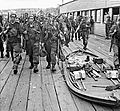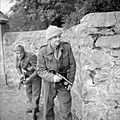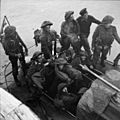List of Commando raids on the Atlantic Wall facts for kids

During World War II, special forces called Commandos carried out many secret missions. These missions were done by soldiers from Britain, the Commonwealth (countries linked to Britain), and a few brave people from countries taken over by Germany. They operated along the "Atlantic Wall", which was a strong line of German defenses stretching from Norway to the border of France and Spain.
Most of these raiding forces were the British Commandos. However, some of the biggest missions, like Operation Gauntlet and Operation Jubilee, also included many Canadian soldiers. The size of these raiding groups varied a lot. The smallest raid, Operation J V, involved only two men. The largest, Operation Jubilee, had over 10,500 soldiers! Most raids lasted just one night, but some, like Operation Gauntlet, went on for several days.
These Commando raids became so effective that in October 1942, Adolf Hitler issued a special order. This order, known as the Commando Order, meant that any captured commandos were to be killed.
Between 1940 and 1944, 57 raids took place. Most of them (36) were in France. There were also 12 raids in Norway, seven in the Channel Islands, and one each in Belgium and the Netherlands. Some raids were very successful, while others faced many problems. For example, the Operation Chariot against the docks at Saint-Nazaire is often called one of the greatest raids ever. But other missions, like Operation Aquatint and Operation Musketoon, ended with most of the commandos being captured or killed.
The Commando raids stopped in mid-1944. Major-General Robert Laycock, the head of Combined Operations Headquarters, decided they were no longer as useful. He believed the raids were only making the Germans build stronger defenses along the coast, which could make future Allied plans harder.
Contents
What Were Commandos?
The Commandos were created after British soldiers had to leave Dunkirk in 1940. Prime Minister Winston Churchill wanted a special force. He wanted them to attack the Germans and help boost British spirits. Churchill asked his military leaders to plan attacks on German-controlled Europe. He said they needed "specially trained troops of the hunter class." These troops would "develop a reign of terror down the enemy coast."
A military officer named Lieutenant Colonel Dudley Clarke had already suggested a similar idea. General Sir John Dill, a top army chief, knew what Churchill wanted. So, he approved Clarke's plan. The first commando raid happened just three weeks later. This first raid didn't gather much information or damage German equipment. Their only success was killing two German guards.
In 1940, the call went out for volunteers. Soldiers already in the army and members of special "Independent Companies" (who had fought in Norway) could join. By November 1940, these new units formed the Special Service Brigade. More than 2,000 men had volunteered for commando training by the autumn of that year.
There were 19 British Army Commando units formed. No. 10 (Inter-Allied) Commando was special. It was made up of volunteers from countries that Germany had taken over. In February 1942, the Royal Marines also formed their own commando units. About 6,000 Marines volunteered! Later, in 1943, the Royal Naval Commandos and Royal Air Force Commandos were formed from sailors and airmen.
Also in 1943, the commandos started to change their role. Instead of just small raids, they began training to lead bigger Allied landings. Most of the remaining 20 Commando units became part of four large "Special Service brigades." These brigades would be the first to land in future invasions. Only a few units, like No. 12, No. 14, and No. 62 Commandos, continued with smaller raids. But by the end of 1943, these units were disbanded because there weren't enough new volunteers. Only No. 10 (Inter-Allied) Commando kept doing small raids. It was the largest commando unit and had special teams trained for parachuting and using canoes.
The Commandos were controlled by the Combined Operations Headquarters. The first leader chosen was Admiral of the Fleet Sir Roger Keyes. He was a hero from World War I. In October 1941, Admiral Louis Mountbatten took over. The last leader of Combined Operations was Major General Robert Laycock, who started in October 1943.
Notable Commando Raids
The Commandos carried out many different types of missions. Here are some examples of their daring operations:
Early Missions
- Operation Collar (June 1940): This was one of the very first raids. About 200 men went to Boulogne and Le Touquet in France. They wanted to scout the area and capture German prisoners. It was mostly a success for morale, as they killed two Germans and returned safely.
- Operation Claymore (March 1941): Around 800 men from No. 3 Commando and No. 4 Commando attacked the Lofoten Islands in Norway. They destroyed factories and captured 228 German prisoners. They also set fire to huge amounts of fish oil and fuel.
- Operation Gauntlet (August-September 1941): This was a larger raid involving 1,500 men, including Canadian troops, in Spitsbergen, Norway. They successfully destroyed coal mining facilities.
Daring and Dangerous Missions
- Operation Archery (December 1941): About 800 commandos from several units attacked Vågsøy, Norway. They destroyed fish oil factories and captured German soldiers. They lost 17 men and 53 were wounded.
- Operation Biting (February 1942): 120 men from the 2nd Parachute Battalion parachuted into Bruneval, France. Their goal was to capture important German radar equipment. This raid was a big success and led to the creation of the Parachute Regiment.
- Operation Chariot (March 1942): This famous raid involved 600 commandos, mainly from No. 2 Commando, attacking the harbor at Saint-Nazaire, France. They aimed to destroy important dock facilities. It's often called one of the greatest raids of all time.
- Operation Jubilee (August 1942): This was a very large raid on Dieppe, France, with 10,500 men, including many Canadians. It was meant to be a "reconnaissance in force" (a strong attack to gather information). However, it ended in a major failure with heavy losses for the Allies. Over 3,300 Canadians and 275 British commandos were killed or wounded.
- Operation Musketoon (September 1942): 12 men from No. 12 Commando attacked an industrial site in Glomfjord, Norway. The raid was successful, but most of the commandos were captured while trying to escape. They were among the first victims of Hitler's Commando Order.
- Operation Frankton (December 1942): 12 Royal Marines in canoes paddled into Bordeaux, France, to attack German shipping. They successfully damaged ships, but only two of the 12 men survived. This brave mission was later made into the film The Cockleshell Heroes.
Reconnaissance and Final Raids
- Operation Hardtack (December 1943): This was a series of raids, mostly by No. 10 (Inter-Allied) Commando, along the French coast and Channel Islands. These missions focused on scouting beaches and defenses, like those that would become Utah Beach. Some raids faced tough challenges, with commandos being injured or captured.
- Operation Tarbrush (May 1944): These were some of the last small-scale raids, again by No. 10 (Inter-Allied) Commando. They involved just two men checking beach obstacles in France. Some were successful, even bringing back a German mine for study.
- Operation Rumford (August 1944): This was one of the very last Commando raids. 10 men from No. 10 (Inter-Allied) Commando went to capture a German-held island, Île d'Yeu, in France. They landed successfully, but the Germans had already left the island.
Images for kids
-
Operation Jubilee destroyed Landing craft on fire with Canadian dead on the beach
-
Wounded commandos after Operation Chariot
-
Two men of 101 (Folbot) Troop, No. 6 Commando training
-
Poles of No. 10 (Inter-Allied) Commando during training in Scotland
-
The two man canoe used in operations J V, Astrakan and Frankton









